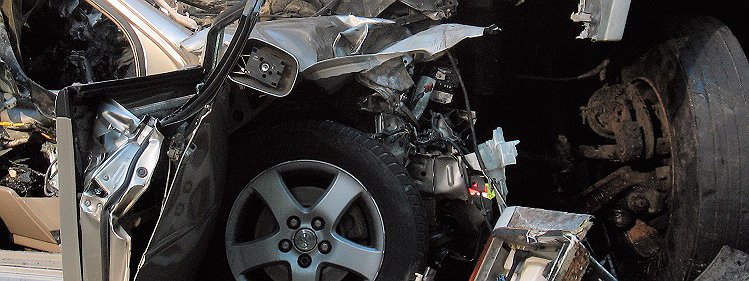Fault for a car accident can mean different things, including any of the following:
(1) who the police officer gave a ticket to under the Highway Traffic Act, or
(2) who is at fault in a civil lawsuit for personal injury, or
(3) who the Insurance Companies deem to be at fault in terms of insurance record and vehicle damage/deductible.
This article will discuss the third category. I have addressed the other two categories in previous articles. This article is simply for general discussion and does not represent formal legal advice. You should consult the legislation or a lawyer for your particular situation.
It should be noted that a decision under category 3 does not really impact on categories 1 and 2 and probably wouldn’t even be admissible into evidence in a personal injury lawsuit.
After a car accident, the people involved will usually call their own insurance companies to report the accident. The first question that most people have is who the insurance company will say is at fault for the accident.
Some people assume that an insurance adjuster just uses their own judgment and makes a decision about who is at fault. However, insurance adjusters refer to something called the “Fault Determination Rules” when deciding who is at fault for an accident. The rules look at different accident scenarios and provide guidance. As of November 2013 when this article was written, the rules can be taken from the legislation and roughly be summarized as follows:
Rules for Automobiles Travelling in the Same Direction and Lane
This section applies when automobile “A” is struck from the rear by automobile “B”, and both automobiles are travelling in the same direction and in the same lane.
If automobile “A” is stopped or is in forward motion, the driver of automobile “A” is not at fault and the driver of automobile “B” is 100 per cent at fault for the incident.
Diagram
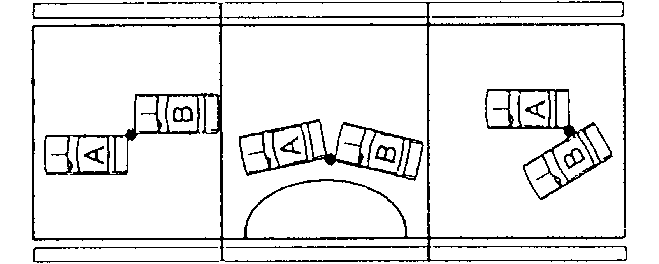
If automobile “A” is turning, either to the right or to the left, in order to enter a side road, private road or driveway, the driver of automobile “A” is not at fault and the driver of automobile “B” is 100 per cent at fault for the incident.
Diagram

If automobile “A” is in forward motion and is entering a parking place on either the right or the left side of the road, the driver of automobile “A” is not at fault and the driver of automobile “B” is 100 per cent at fault for the incident.
Diagram
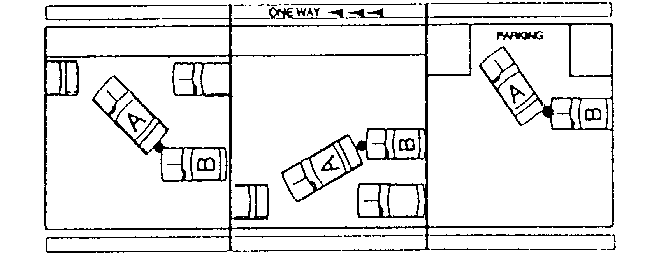
This section applies when automobile “A” collides with automobile “B” while automobile “B” is entering a road from a parking place, private road or driveway.
If the incident occurs when automobile “B” is leaving a parking place and automobile “A” is passing the parking place, the driver of automobile “A” is not at fault and the driver of automobile “B” is 100 per cent at fault for the incident.
Diagram
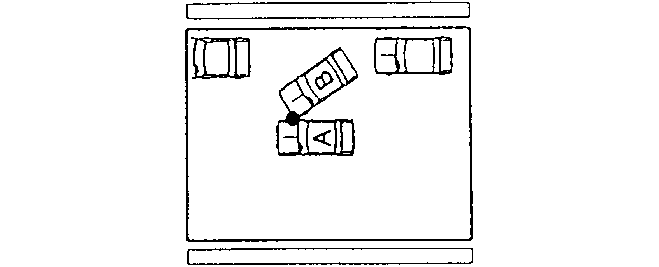
If the incident occurs when automobile “B” is entering a road from a private road or a driveway and automobile “A” is passing the private road or driveway and, if there are no traffic signals or signs, the driver of automobile “A” is not at fault and the driver of automobile “B” is 100 per cent at fault for the incident.
Diagram
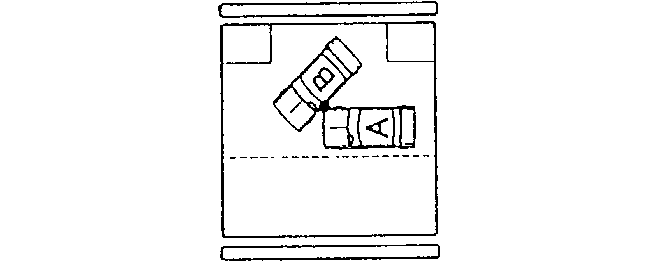
If automobile “A” collides with automobile “B” on a controlled access road while automobile “B” is entering the road from an entrance lane, the driver of automobile “A” is not at fault and the driver of automobile “B” is 100 per cent at fault for the incident.
Diagram
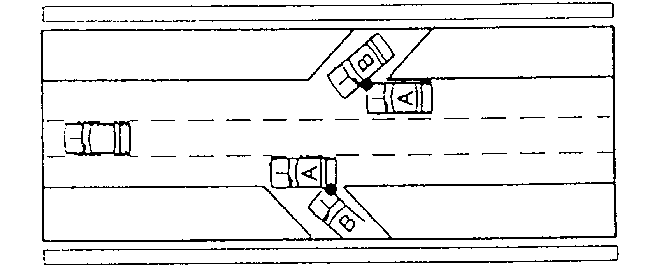
Chain Reaction Collisions
In an incident involving three or more automobiles that are travelling in the same direction and in the same lane (a “chain reaction”)
- The degree of fault for each collision between two automobiles involved in the chain reaction is determined without reference to any related collisions involving either of the automobiles and another automobile.
- If all automobiles involved in the incident are in motion and automobile “A” is the leading vehicle, automobile “B” is second and automobile “C” is the third vehicle,
- in the collision between automobiles “A” and “B”, the driver of automobile “A” is not at fault and the driver of automobile “B” is 50 per cent at fault for the incident;
- in the collision between automobiles “B” and “C”, the driver of automobile “B” is not at fault and the driver of automobile “C” is 100 per cent at fault for the incident.
Diagram
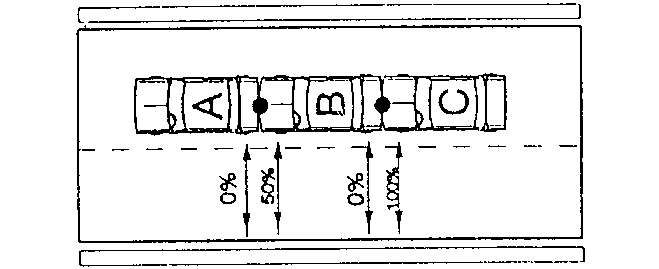
- If only automobile “C” is in motion when the incident occurs,
- in the collision between automobiles “A” and “B”, neither driver is at fault for the incident; and
- in the collision between automobiles “B” and “C”, the driver of automobile “B” is not at fault and the driver of automobile “C” is 100 per cent at fault for the incident.
Diagram
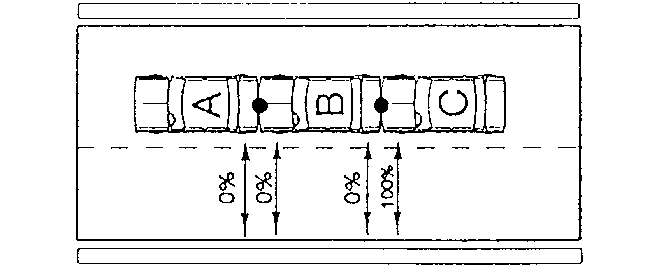
Rules for Automobiles Travelling in the Same Direction in Adjacent Lane
This section applies when automobile “A” collides with automobile “B”, and both automobiles are travelling in the same direction and in adjacent lanes.
If neither automobile “A” nor automobile “B” changes lanes, and both automobiles are on or over the centre line when the incident (a “sideswipe”) occurs, the driver of each automobile is 50 per cent at fault for the incident.
Diagram
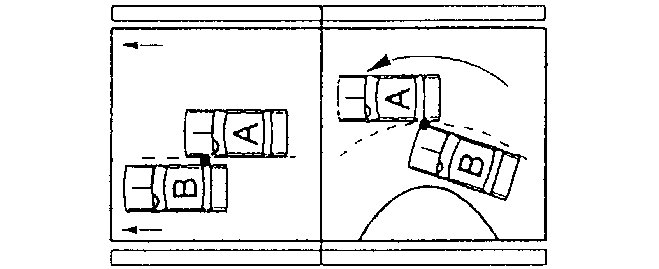
If the location on the road of automobiles “A” and “B” when the incident (a “sideswipe”) occurs cannot be determined, the driver of each automobile is 50 per cent at fault for the incident.
Diagram
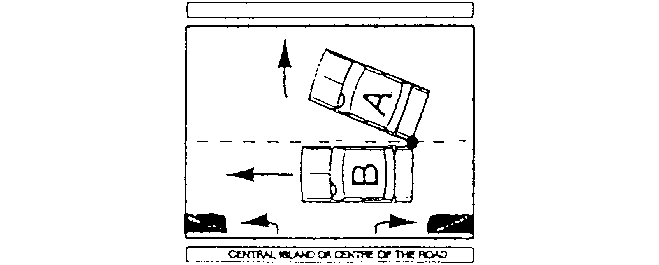
(4) If the incident occurs when automobile “B” is changing lanes, the driver of automobile “A” is not at fault and the driver of automobile “B” is 100 per cent at fault for the incident.
Diagram
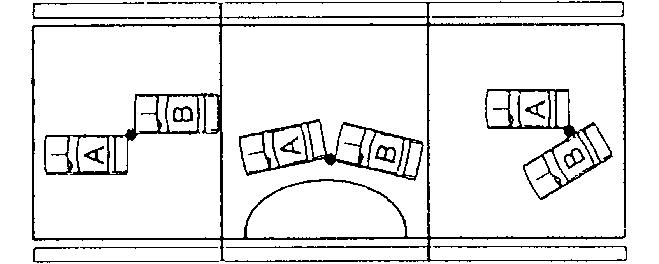
(5) If the incident occurs when automobile “A” is turning left at an intersection and automobile “B” is overtaking automobile “A” to pass it, the driver of automobile “A” is 25 per cent at fault and the driver of automobile “B” is 75 per cent at fault for the incident.
Diagram
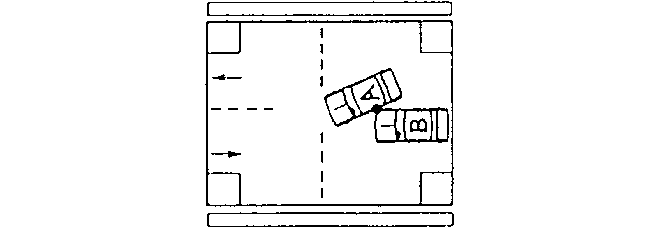
(6) If the incident occurs when automobile “A” is turning left at a private road or a driveway and automobile “B” is overtaking automobile “A” to pass it, the driver of each automobile is 50 per cent at fault for the incident.
Diagram
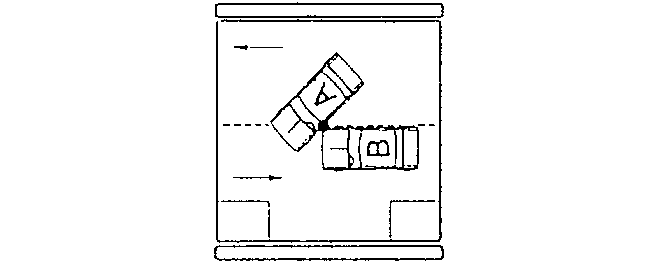
(7) If the incident occurs when automobile “A” is turning left at a private road or a driveway and automobile “B” is passing one or more automobiles stopped behind automobile “A”, the driver of automobile “A” is not at fault and the driver of automobile “B” is 100 per cent at fault for the incident.
Diagram
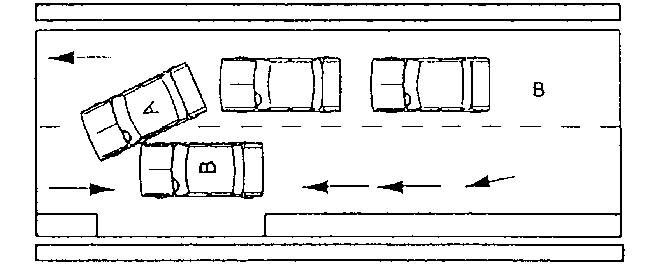
This section applies with respect to an incident involving three or more automobiles that are travelling in the same direction and in adjacent lanes (a “pile-up”).
- For each collision between two automobiles involved in the pile-up, the driver of each automobile is 50 per cent at fault for the incident.
Diagram
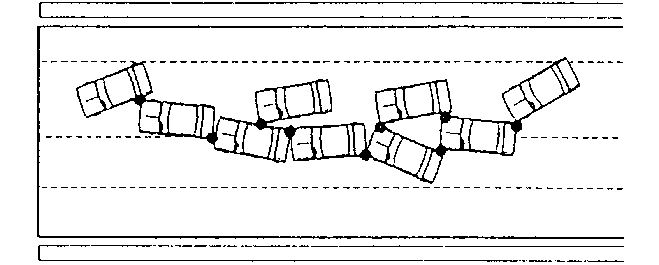
Rules for Automobiles Travelling in Opposite Directions
- This section applies when automobile “A” collides with automobile “B”, and the automobiles are travelling in opposite directions and in adjacent lanes.
-If neither automobile “A” nor automobile “B” changes lanes and both automobiles are on or over the centre lane when the incident (a “sideswipe”) occurs, the driver of each automobile is 50 per cent at fault for the incident.
Diagram
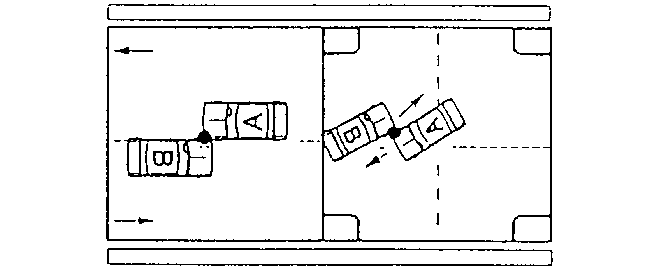
-If the location on the road of automobiles “A” and “B” when the incident (a “sideswipe”) occurs cannot be determined, the driver of each automobile is 50 per cent at fault for the incident.
Diagram
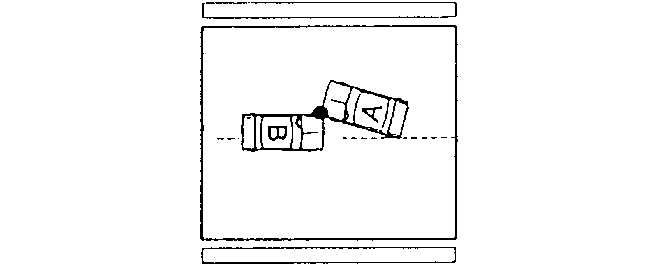
- If automobile “B” is over the centre line of the road when the incident occurs, the driver of automobile “A” is not at fault and the driver of automobile “B” is 100 per cent at fault for the incident.
Diagram
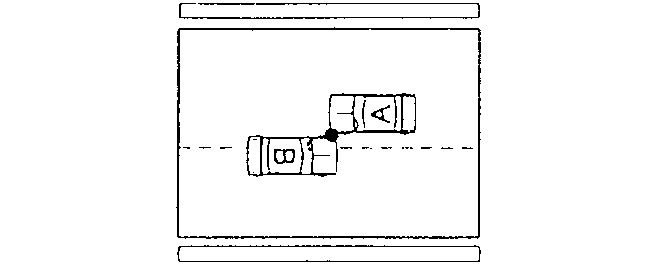
- If automobile “B” turns left into the path of automobile “A”, the driver of automobile “A” is not at fault and the driver of automobile “B” is 100 per cent at fault for the incident.
Diagram
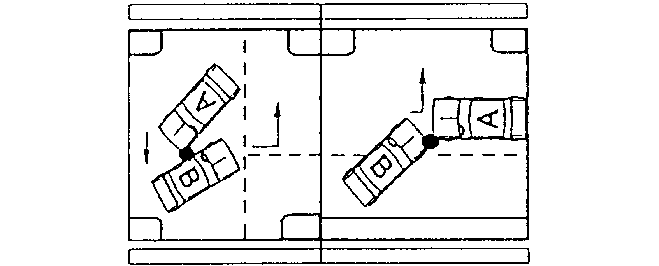
- If automobile “B” is leaving a parking place or is entering the road from a private road or driveway, and if automobile “A” is overtaking to pass another automobile when the incident occurs, the driver of automobile “A” is not at fault and the driver of automobile “B” is 100 per cent at fault for the incident.
Diagram
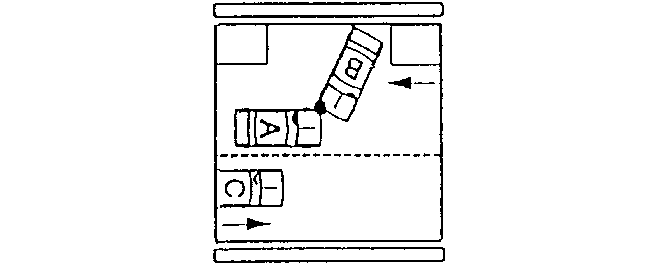
Rules for Automobiles in an Intersection
- This section applies with respect to an incident that occurs at an intersection that does not have traffic signals or traffic signs.
- If automobile “A” enters the intersection before automobile “B”, the driver of automobile “A” is not at fault and the driver of automobile “B” is 100 per cent at fault for the incident.
- If automobiles “A” and “B” enter the intersection at the same time and automobile “A” is to the right of automobile “B” when in the intersection, the driver of automobile “A” is not at fault and the driver of automobile “B” is 100 per cent at fault for the incident.
- If it cannot be established whether automobile “A” or “B” entered the intersection first, the driver of each automobile shall be deemed to be 50 per cent at fault for the incident.
- This section applies with respect to an incident that occurs at an intersection with traffic signs.
- If the incident occurs when the driver of automobile “B” fails to obey a stop sign, yield sign or a similar sign or flares or other signals on the ground, the driver of automobile “A” is not at fault and the driver of automobile “B” is 100 per cent at fault for the incident.
- If the driver of each automobile fails to obey a stop sign, the driver of each automobile is 50 per cent at fault for the incident.
- If it cannot be established who failed to obey a stop sign, the driver of each automobile shall be deemed to be 50 per cent at fault for the incident.
- If, at an all-way stop intersection, automobile “A” arrives at the intersection first and stops, the driver of automobile “A” is not at fault and the driver of automobile “B” is 100 per cent at fault for the incident.
- If, at an all-way stop intersection, both automobiles arrive at the intersection at the same time and stop, with automobile “A” to the right of automobile “B”, the driver of automobile “A” is not at fault and the driver of automobile “B” is 100 per cent at fault for the incident.
-If it cannot be established who arrived at the all-way stop intersection first, the driver of each automobile shall be deemed to be 50 per cent at fault for the incident.
- This section applies with respect to an incident that occurs at an intersection with traffic signals.
- If the driver of automobile “B” fails to obey a traffic signal, the driver of automobile “A” is not at fault and the driver of automobile “B” is 100 per cent at fault for the incident.
- If it cannot be established whether the driver of either automobile failed to obey a traffic signal, the driver of each automobile shall be deemed to be 50 per cent at fault for the incident.
- If the traffic signals at the intersection are inoperative, the degree of fault of the drivers shall be determined as if the intersection were an all-way stop intersection.
Rules for Automobiles in Parking Lots
- This section applies with respect to incidents in parking lots.
- The degree of fault of a driver involved in an incident on a thoroughfare shall be determined in accordance with this Regulation as if the thoroughfare were a road.
- If automobile “A” is leaving a feeder lane and fails to yield the right of way to automobile “B” on a thoroughfare, the driver of automobile “A” is 100 per cent at fault and the driver of automobile “B” is not at fault for the incident.
- If automobile “A” is leaving a parking space and fails to yield the right of way to automobile “B” on a feeder lane or a thoroughfare, the driver of automobile “A” is 100 per cent at fault and the driver of automobile “B” is not at fault for the incident.
- In this section,
“feeder lane” means a road in a parking lot other than a thoroughfare;
“thoroughfare” means a main road for passage into, through or out of a parking lot.
Rules for Other Circumstances
- If automobile “A” is parked when it is struck by automobile “B”, the driver of automobile “A” is not at fault and the driver of automobile “B” is 100 per cent at fault for the incident.
- If automobile “A” is illegally parked, stopped or standing when it is struck by automobile “B” and if the incident occurs outside a city, town or village, the driver of automobile “A” is 100 per cent at fault and the driver of automobile “B” is not at fault for the incident.
- The driver of automobile “A” is 100 per cent at fault and the driver of automobile “B” is not at fault for an incident in which automobile “A” collides with automobile “B” when the driver of automobile “A” fails to obey,
(a) a police officer’s direction;
(b) a do not enter sign;
(c) a prohibited passing sign; or
(d) a prohibited turn sign.
- The driver of automobile “A” is 100 per cent at fault and the driver of automobile “B” is not at fault for an incident that occurs,
(a) when automobile “A” is backing up;
(b) when automobile “A” is making a U-turn; or
(c) when the driver of, or a passenger in, automobile “A” opens the automobile door or leaves the door open.
Rules When a Driver is Charged with a Driving Offence
- For the purposes of this Regulation, a driver is considered to be charged with a driving offence,
(a) if, as a result of the incident, the driver is charged with operating the automobile while his or her ability to operate the automobile was impaired by alcohol or a drug;
(b) if, as a result of the incident, the driver is charged with driving while his or her blood alcohol level exceeded the limits permitted by law;
(c) if, as a result of the incident, the driver is charged with an indictable offence related to the operation of the automobile;
(d) if the driver, as a result of the incident, is asked to provide a breath sample and he or she is charged with failing or refusing to provide the sample;
(e) if, as a result of the incident, the driver is charged with exceeding the speed limit by sixteen or more kilometres per hour.
(2) The degree of fault of the insured shall be determined in accordance with the ordinary rules of law, and not in accordance with these rules,
(a) if the driver of automobile “A” involved in the incident is charged with a driving offence; and
(b) if the driver of automobile “B” is wholly or partly at fault, as otherwise determined under these rules, for the incident.

